I have been growing grapes for several years, and I have found that companion planting is an excellent way to improve the health and yield of grape plants. Companion planting involves growing different plants together to create a mutually beneficial relationship. When it comes to grapes, companion planting can help attract beneficial insects, improve soil health, and reduce pest problems.
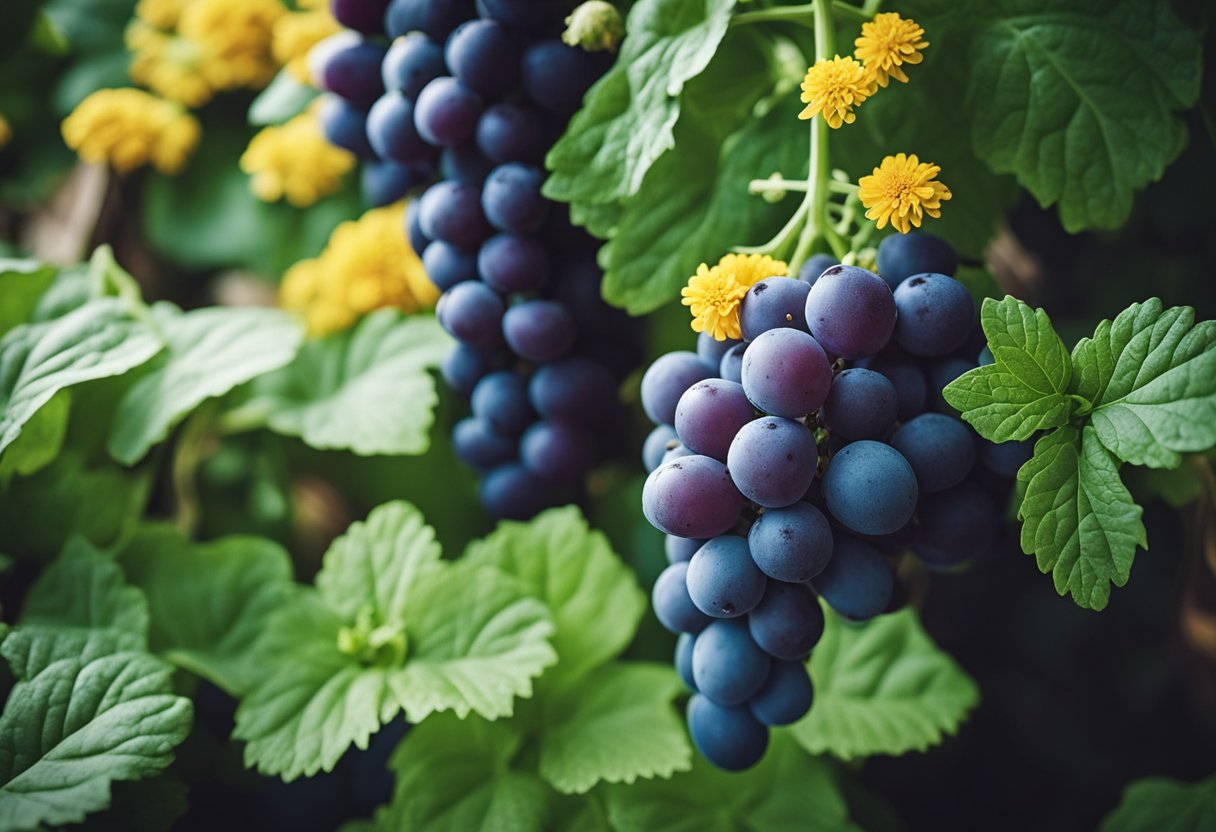
Companion planting offers several benefits for grape growers. By planting certain plants near grapevines, you can attract beneficial insects that help control pests and pollinate the flowers. Additionally, companion plants can help improve soil health by adding nutrients, improving soil structure, and increasing water retention. Some companion plants can also help reduce pest problems by repelling or distracting pests from the grapevines.
Choosing the right companion plants for grapes is essential for a successful harvest. Some plants, such as herbs and flowers, are excellent for attracting beneficial insects, while others, such as legumes, can help fix nitrogen in the soil. It’s also essential to consider the growth habits of the companion plants and how they will interact with the grapevines. With careful planning and consideration, companion planting can help improve the health and yield of grape plants.
Key Takeaways
- Companion planting can help attract beneficial insects, improve soil health, and reduce pest problems for grape growers.
- Choosing the right companion plants for grapes is essential for a successful harvest.
- With careful planning and consideration, companion planting can help improve the health and yield of grape plants.
Benefits of Companion Planting for Grapes
As a grape grower, I have found that companion planting is an effective way to improve the health and yield of my grapevines. Companion planting involves growing two or more different plants in close proximity to one another for mutual benefit. Here are some of the benefits of companion planting for grapes.
Attracting Beneficial Insects
Companion planting with plants such as buckwheat, clover, and dill can attract beneficial insects such as ladybugs, lacewings, and hoverflies that prey on grape pests like aphids and spider mites. This can help reduce the need for chemical pesticides, making it a more sustainable and environmentally friendly approach to grape growing.
Improving Soil Health
Certain companion plants such as legumes, like clover and alfalfa, can fix nitrogen in the soil, which can improve the overall health and fertility of the soil. This can lead to healthier grapevines that produce higher quality fruit.
Controlling Weeds
Companion planting with plants like cover crops can help control weeds by shading out the weeds and competing with them for nutrients and water. This can reduce the need for herbicides and manual weeding, saving time and money.
Enhancing Flavor
Companion planting with herbs like thyme, rosemary, and sage can enhance the flavor of grapes and improve the taste of wine made from those grapes. These herbs can also deter pests and diseases, making them a great addition to any grapevine planting.
Companion planting is a simple and effective way to improve the health and yield of grapevines while reducing the need for chemical inputs. By planting companion plants that attract beneficial insects, improve soil health, control weeds, and enhance flavor, grape growers can enjoy a more sustainable and environmentally friendly approach to grape growing.
Choosing the Right Companion Plants
As a grape grower, I know that choosing the right companion plants can help improve the health and productivity of my grape vines. Companion plants provide a range of benefits to grape vines, including attracting beneficial insects, providing shade and shelter, and improving soil health. In this section, I will discuss some of the best companion plants for grape vines.
Herbs and Flowers
Herbs and flowers are excellent companion plants for grape vines. They attract beneficial insects such as bees, ladybugs, and lacewings, which help to pollinate the grape vines and control pest populations. Some of the best herbs and flowers to plant alongside grape vines include:
- Lavender: Lavender attracts bees and other beneficial insects, and its strong scent helps to repel pests such as moths and fleas.
- Marigolds: Marigolds are a natural insecticide and can help to repel pests such as nematodes, whiteflies, and aphids.
- Rosemary: Rosemary is a natural insecticide and can help to repel pests such as flies, mosquitoes, and cabbage moths.
Vegetables
Vegetables are also great companion plants for grape vines. They help to improve soil health by adding nutrients and organic matter, and they can also attract beneficial insects. Some of the best vegetables to plant alongside grape vines include:
- Beans: Beans are nitrogen-fixing plants that help to improve soil health. They also attract beneficial insects such as bees and ladybugs.
- Cucumbers: Cucumbers are a natural insecticide and can help to repel pests such as ants, beetles, and aphids.
- Peppers: Peppers are a natural insecticide and can help to repel pests such as spider mites and aphids.
Fruit Trees
Fruit trees are another great companion plant for grape vines. They provide shade and shelter for the grape vines, and they can also attract beneficial insects. Some of the best fruit trees to plant alongside grape vines include:
- Apples: Apples attract beneficial insects such as bees and ladybugs, and their shade can help to protect the grape vines from sunburn.
- Cherries: Cherries are a natural insecticide and can help to repel pests such as aphids and spider mites.
- Peach: Peach trees attract beneficial insects such as bees and ladybugs, and their shade can help to protect the grape vines from sunburn.
Choosing the right companion plants can help to improve the health and productivity of your grape vines. By planting herbs and flowers, vegetables, and fruit trees alongside your grape vines, you can attract beneficial insects, improve soil health, and protect your grape vines from pests and sunburn.
Companion Planting Strategies
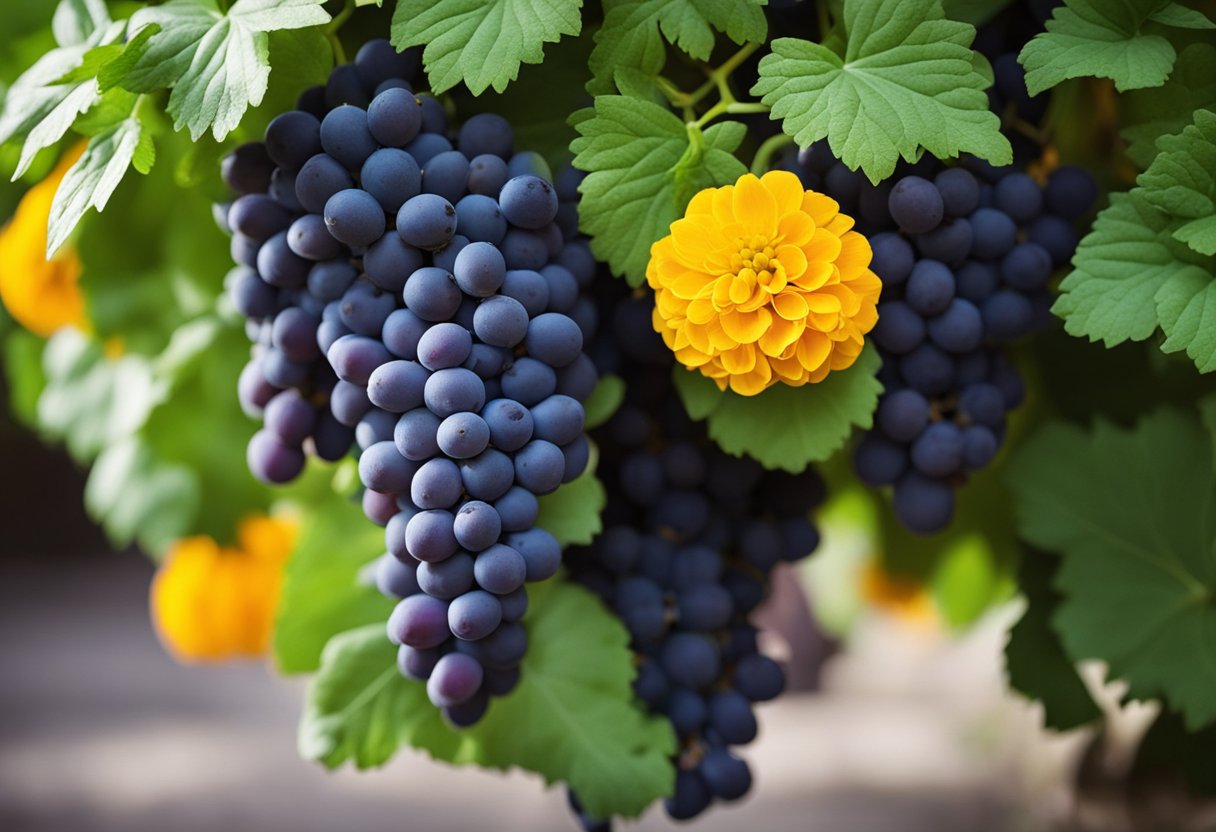
As a grape grower, I have found that companion planting is an effective way to improve the health and yield of my grapevines. Companion planting is the practice of planting two or more plants together that benefit each other in some way. Here are some strategies that I have found useful for companion planting with grapevines.
Spatial Arrangement
The spatial arrangement of companion plants is an important consideration for effective companion planting. When planting companion plants, it is important to consider their size, growth habit, and root structure. For example, planting shallow-rooted plants like lettuce or radish near grapevines may compete for water and nutrients, which can negatively affect grapevine growth.
On the other hand, planting deep-rooted plants like comfrey or yarrow near grapevines can help to break up compacted soil, improve soil structure, and increase water infiltration. Additionally, planting plants with different heights, such as tall sunflowers or corn, can provide shade and wind protection for grapevines.
Timing and Seasonality
Timing and seasonality are also important factors to consider when companion planting with grapevines. For example, planting cover crops like clover or vetch in the fall after grape harvest can help to fix nitrogen in the soil and improve soil health for the next growing season.
Planting herbs like basil or chamomile in the spring can attract beneficial insects like bees and wasps that can help to pollinate grapevines and control pests. Additionally, planting plants with different bloom times can provide a continuous source of nectar and pollen for beneficial insects throughout the growing season.
By carefully selecting and planting companion plants, grape growers can improve soil health, increase grapevine growth and yield, and reduce the need for chemical inputs.
Common Grape Varieties and Their Companions
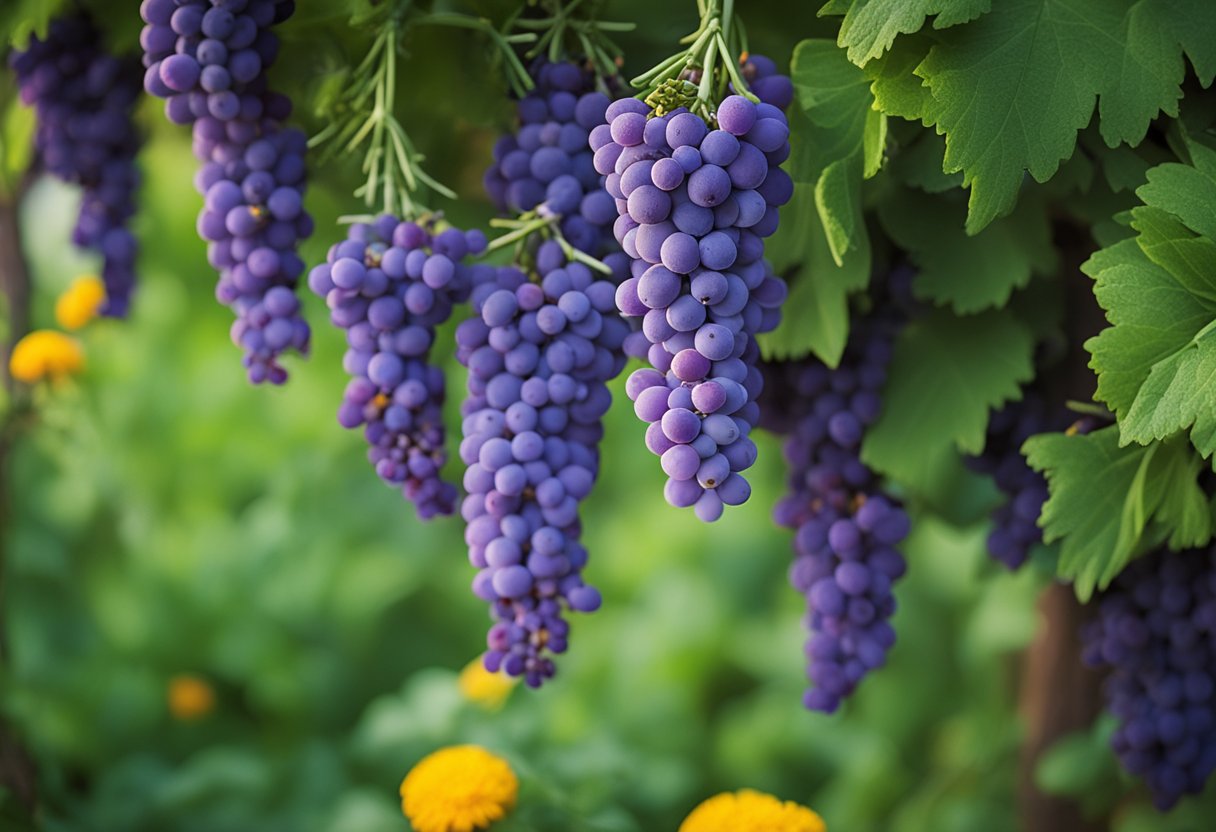
Grapes are a popular fruit that are used for wine, juice, and snacking. There are many different kinds of grapes, each with their own unique flavor and characteristics. As a grape grower, it is important to know which varieties are best suited for your region and what companion plants can help improve the growth and health of your grapevines.
Here are some common grape varieties and their companions:
1. Cabernet Sauvignon
Cabernet Sauvignon is a popular grape variety that is known for its full-bodied flavor and high tannins. This grape variety grows well in warm, dry climates and is often paired with other grape varieties such as Merlot and Cabernet Franc. Some companion plants that can help improve the growth of Cabernet Sauvignon include:
- Lavender: Lavender is a fragrant herb that can help repel pests and attract beneficial insects to your grapevines.
- Rosemary: Rosemary is another herb that can help repel pests and attract beneficial insects to your grapevines. It also has anti-fungal properties that can help prevent diseases from spreading.
- Marigolds: Marigolds are colorful flowers that can help repel pests and attract beneficial insects to your grapevines. They are also easy to grow and can add a pop of color to your vineyard.
2. Chardonnay
Chardonnay is a white grape variety that is known for its buttery flavor and high acidity. This grape variety grows well in cool, moderate climates and is often paired with other white grape varieties such as Pinot Grigio and Sauvignon Blanc. Some companion plants that can help improve the growth of Chardonnay include:
- Dill: Dill is an herb that can help repel pests and attract beneficial insects to your grapevines. It also has anti-fungal properties that can help prevent diseases from spreading.
- Nasturtiums: Nasturtiums are colorful flowers that can help repel pests and attract beneficial insects to your grapevines. They are also edible and can be used in salads or as a garnish.
- Fennel: Fennel is an herb that can help repel pests and attract beneficial insects to your grapevines. It also has anti-fungal properties that can help prevent diseases from spreading.
3. Pinot Noir
Pinot Noir is a red grape variety that is known for its light-bodied flavor and low tannins. This grape variety grows well in cool, moderate climates and is often paired with other red grape varieties such as Gamay and Syrah. Some companion plants that can help improve the growth of Pinot Noir include:
- Thyme: Thyme is an herb that can help repel pests and attract beneficial insects to your grapevines. It also has anti-fungal properties that can help prevent diseases from spreading.
- Mint: Mint is another herb that can help repel pests and attract beneficial insects to your grapevines. It also has a refreshing scent that can help mask any unpleasant odors in your vineyard.
- Chives: Chives are an herb that can help repel pests and attract beneficial insects to your grapevines. They are also edible and can be used in a variety of dishes.
Knowing which companion plants to grow alongside your grapevines can help improve their growth and health. By planting a variety of herbs and flowers, you can create a diverse ecosystem in your vineyard that can help keep pests and diseases at bay.
Pest Management with Companion Plants
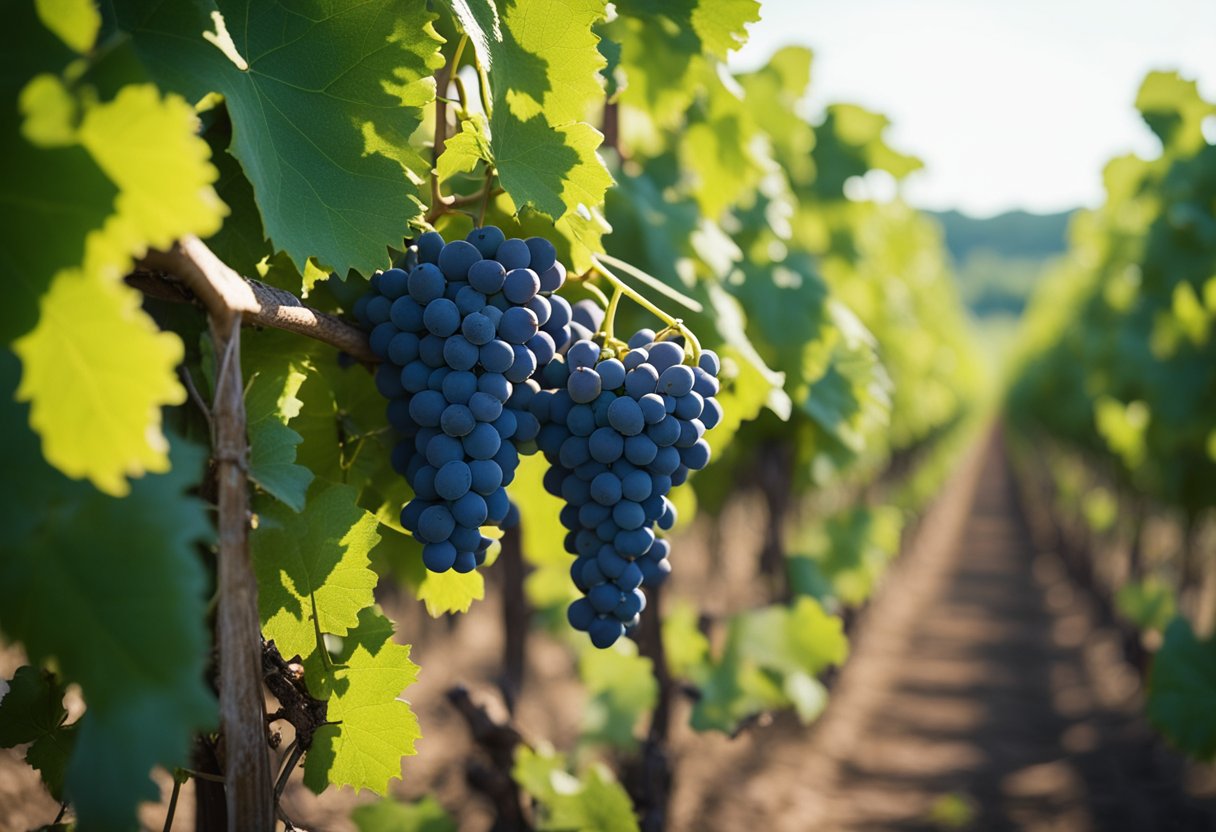
As a grape grower, I understand the importance of pest management to ensure a healthy and productive crop. While traditional pest control methods involve the use of chemical pesticides, I prefer using companion plants to manage pests in my vineyard.
Companion planting involves growing two or more plant species together to provide mutual benefits. In the case of pest management, companion plants can be used to attract beneficial insects that prey on pests, repel pests, or mask the scent of grapevines, making them less attractive to pests.
Some examples of companion plants that can be used for pest management in grapevines include:
- Marigolds: These flowers release a chemical that repels nematodes, which can damage grapevine roots. They also attract beneficial insects such as ladybugs and lacewings, which feed on aphids and other pests.
- Lavender: This fragrant herb repels moths and other flying insects that can damage grapevines. It also attracts bees and other pollinators, which are essential for grape production.
- Clover: This ground cover attracts beneficial insects such as parasitic wasps and hoverflies, which feed on aphids and other pests. It also fixes nitrogen in the soil, which can benefit grapevines.
By incorporating companion plants into my grapevine rows, I have been able to reduce my reliance on chemical pesticides and promote a healthier, more diverse ecosystem in my vineyard.
Soil Improvement and Mulching Techniques

As a grape grower, I have found that soil improvement and mulching techniques are crucial for maintaining healthy grapevines. Proper soil management can lead to better grape quality, yield, and flavor. In this section, I will discuss some of the most effective soil improvement and mulching techniques that I have used in my vineyard.
Organic Mulches
Organic mulches are a fantastic way to improve soil quality and reduce weed growth. I have found that straw and living mulch are particularly effective in reducing weed populations, maintaining grapevine productivity, and improving several indicators of soil quality. Organic mulches also help to conserve soil moisture, prevent compaction, moderate soil temperatures, reduce erosion, and improve soil tilth and organic matter.
Inorganic Mulches
Inorganic mulches such as plastic, gravel, and stones can also be used to improve soil quality and reduce weed growth. However, these types of mulches are not as effective as organic mulches in promoting healthy soil. Inorganic mulches can also increase soil temperature, which can be detrimental to grapevines in hot climates.
Cover Crops
Cover crops are another effective way to improve soil quality and reduce weed growth. I have found that planting legumes such as clover and vetch can help to fix nitrogen in the soil, which is essential for healthy grapevine growth. Cover crops can also help to prevent soil erosion, improve soil structure, and increase soil organic matter.
Compost
Composting is an excellent way to improve soil quality and add nutrients to the soil. I have found that adding compost to the soil can help to improve soil structure and water-holding capacity, increase soil organic matter, and promote healthy microbial activity in the soil. Composting is also an effective way to recycle organic waste and reduce landfill waste.
Soil improvement and mulching techniques are essential for maintaining healthy grapevines. Organic mulches, inorganic mulches, cover crops, and composting are all effective ways to improve soil quality and reduce weed growth. By using these techniques, grape growers can promote healthy soil, improve grape quality, yield, and flavor, and reduce their environmental impact.
Irrigation and Watering Considerations
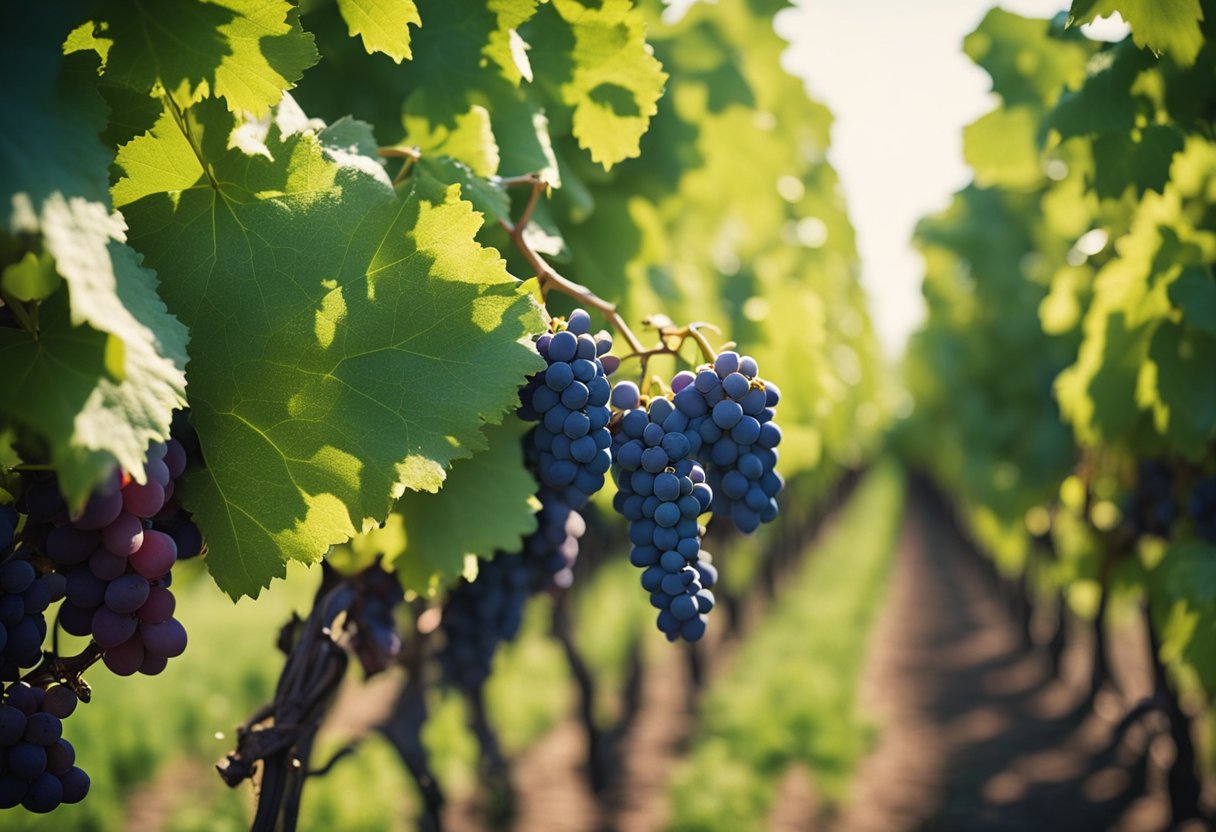
When it comes to growing companion plants for grape, irrigation and watering considerations are crucial. Grapevines require a significant amount of water to grow and produce fruit. Therefore, it is important to ensure that companion plants do not compete for water with grapevines.
One way to avoid competition for water is to select companion plants that have similar water requirements to grapevines. For example, plants such as lavender, thyme, and sage are drought-tolerant and can thrive with minimal watering. These plants can be excellent companions for grapevines, as they require less water than other plants and can help conserve water in the vineyard.
Another way to conserve water in the vineyard is to use irrigation systems that are efficient and precise. Drip irrigation is a popular choice for grape growers, as it delivers water directly to the roots of the plants, minimizing water loss due to evaporation or runoff. Additionally, monitoring soil moisture levels can help growers determine when to water their plants, preventing over or under-watering.
Selecting companion plants that have similar water requirements to grapevines and using efficient irrigation systems can help conserve water and ensure the healthy growth of both grapevines and companion plants.
Pruning and Maintenance of Grape Vines
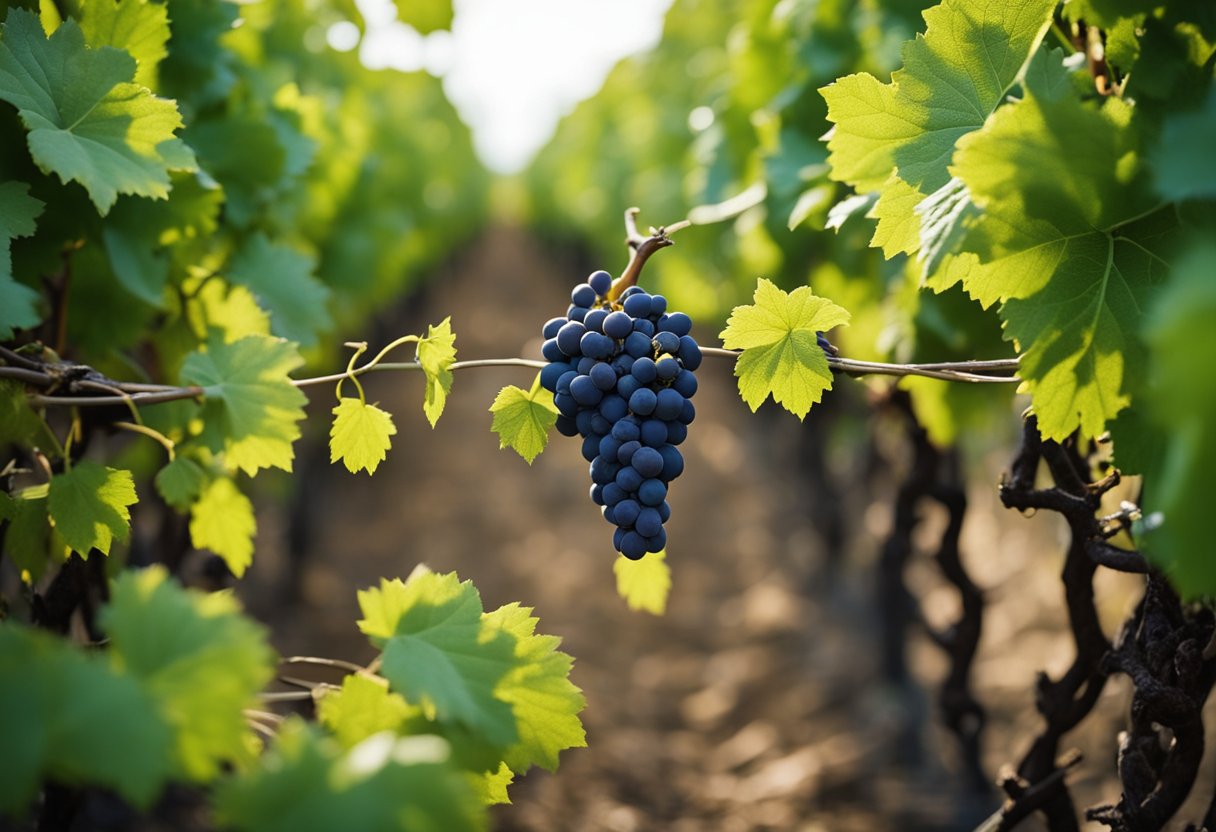
As a grape grower, I know that pruning and maintenance of grape vines are essential to ensure healthy growth and high-quality fruit production. Proper pruning techniques help to control the growth of the vine, improve air circulation, and increase sunlight exposure to the fruit. Here are some tips for pruning and maintaining grape vines:
Pruning
Grape vines require annual pruning to remove old wood, stimulate new growth, and maintain the desired shape and size of the vine. Pruning should be done during the dormant season, typically in late winter or early spring, before the buds start to swell.
There are different pruning techniques that can be used depending on the grape variety, training system, and desired production level. Some common pruning techniques include:
- Spur pruning: This technique involves cutting back the previous year’s growth to a few buds, leaving short spurs that will produce fruiting canes.
- Cane pruning: This technique involves removing most of the previous year’s growth, leaving one or two long canes that will produce fruiting spurs.
- Guyot pruning: This technique involves removing most of the previous year’s growth, leaving one long cane with a few buds and a spur with two or three buds.
The choice of pruning technique will depend on the grape variety and the training system used. It is important to consult with a local expert or extension agent to determine the best pruning technique for your vineyard.
Maintenance
In addition to pruning, grape vines require regular maintenance to ensure healthy growth and fruit production. Some maintenance tasks include:
- Fertilization: Grape vines require regular fertilization to provide essential nutrients for growth and fruit production. It is important to use a balanced fertilizer and to follow recommended application rates.
- Irrigation: Grape vines require regular irrigation to ensure adequate moisture for growth and fruit production. It is important to monitor soil moisture levels and adjust irrigation accordingly.
- Pest and disease control: Grape vines are susceptible to a variety of pests and diseases, including powdery mildew, downy mildew, and phylloxera. It is important to monitor vines regularly for signs of pests and diseases and to take appropriate control measures.
By following these tips for pruning and maintenance, you can ensure healthy growth and high-quality fruit production in your grape vineyard.
Harvesting and Utilization of Companion Plants
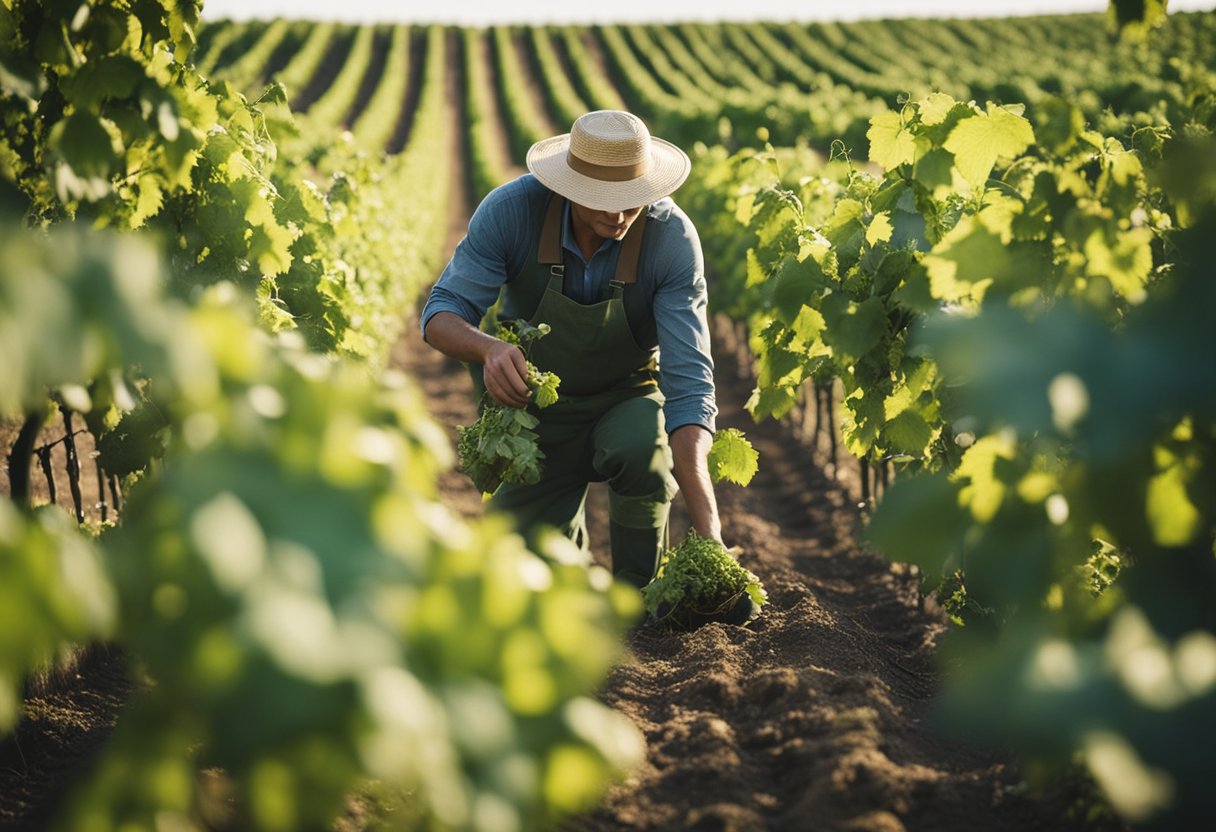
As I have researched, companion plants are a great way to improve the health and productivity of grapevines. They can help repel pests, attract beneficial insects, and improve soil quality. In this section, I will discuss the harvesting and utilization of companion plants for grapevines.
Harvesting
Companion plants can be harvested for various purposes, such as culinary, medicinal, or ornamental. For example, herbs like basil, oregano, and thyme can be used to flavor dishes, and lavender can be used to make essential oils. It is important to harvest companion plants at the right time to ensure their effectiveness. For instance, chamomile should be harvested when the flowers are fully open, while comfrey should be harvested before the flowers bloom.
Utilization
Companion plants can be utilized in different ways to benefit grapevines. Some plants can be intercropped with grapevines to provide shade and reduce water stress. For example, clover can be planted between rows of grapevines to improve soil quality and attract beneficial insects. Other plants can be used as a natural pest control method. For instance, marigolds can repel nematodes and other harmful insects, while garlic can repel grapevine moths.
In addition, companion plants can be used to attract pollinators and beneficial insects. Plants like yarrow, dill, and fennel can attract bees, butterflies, and ladybugs, which can help pollinate grapevines and control pests. Some companion plants can also be used as a cover crop to prevent erosion and improve soil structure. For example, legumes like beans and peas can fix nitrogen in the soil and improve soil fertility.
Harvesting and utilizing companion plants can be a great way to improve the health and productivity of grapevines. By intercropping, repelling pests, attracting beneficial insects, and improving soil quality, companion plants can help create a healthy and sustainable vineyard ecosystem.
FAQs – Companion Plants for Grape
What are the best companion plants to pair with grapevines?
Grapevines thrive when planted with certain companion plants. The most effective companion plants for grapevines are those that attract beneficial insects, such as ladybugs, lacewings, and parasitic wasps. Some examples of companion plants that attract these insects include marigolds, cosmos, and yarrow. Additionally, planting herbs like basil, thyme, and oregano can help repel pests and improve the flavor of grapes.
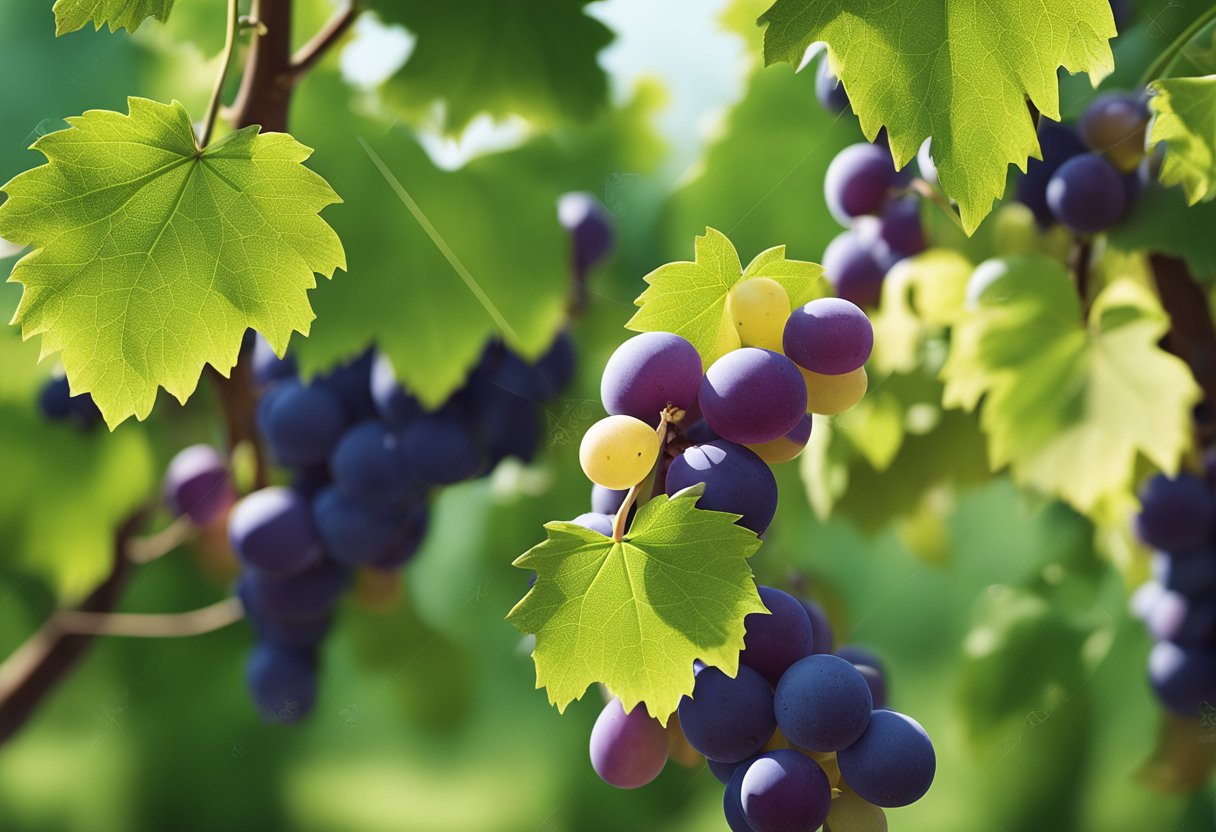
Are sunflowers beneficial when planted near grapevines?
Sunflowers can be beneficial when planted near grapevines. They attract beneficial insects like bees, which can help with pollination. However, sunflowers can also attract pests like aphids, which can damage grapevines. Therefore, it is recommended to plant sunflowers at a distance from grapevines or to plant them in a different area altogether.
What should be planted around vineyards to help detect diseases?
Planting flowers like roses and phlox around vineyards can help detect diseases. These flowers are susceptible to many of the same diseases that affect grapevines, making them good indicators of disease presence. Additionally, planting cover crops like clover and vetch can help improve soil health and reduce the risk of disease.
What are the negative effects of planting grapes near certain vegetables?
Planting grapes near certain vegetables can have negative effects on both the grapes and the vegetables. For example, planting grapes near members of the nightshade family, such as tomatoes and peppers, can increase the risk of disease and pest problems for both crops. Additionally, planting grapes near plants that require high levels of nitrogen, such as corn and beans, can lead to stunted grape growth and reduced grape yields.
Is it advisable to grow grapes in proximity to strawberry plants?
Growing grapes in proximity to strawberry plants is not advisable. Strawberries are susceptible to a number of fungal diseases that can spread to grapevines, and the two crops have different nutrient requirements. Additionally, strawberries can attract pests like birds, which can damage grapevines.
Can lavender be used as a companion plant for grapevines?
Lavender can be used as a companion plant for grapevines. It attracts beneficial insects like bees and butterflies, which can help with pollination, and it can also repel pests like moths and fleas. Additionally, the scent of lavender can help mask the scent of ripening grapes, which can help deter birds and other animals from feeding on the grapes.